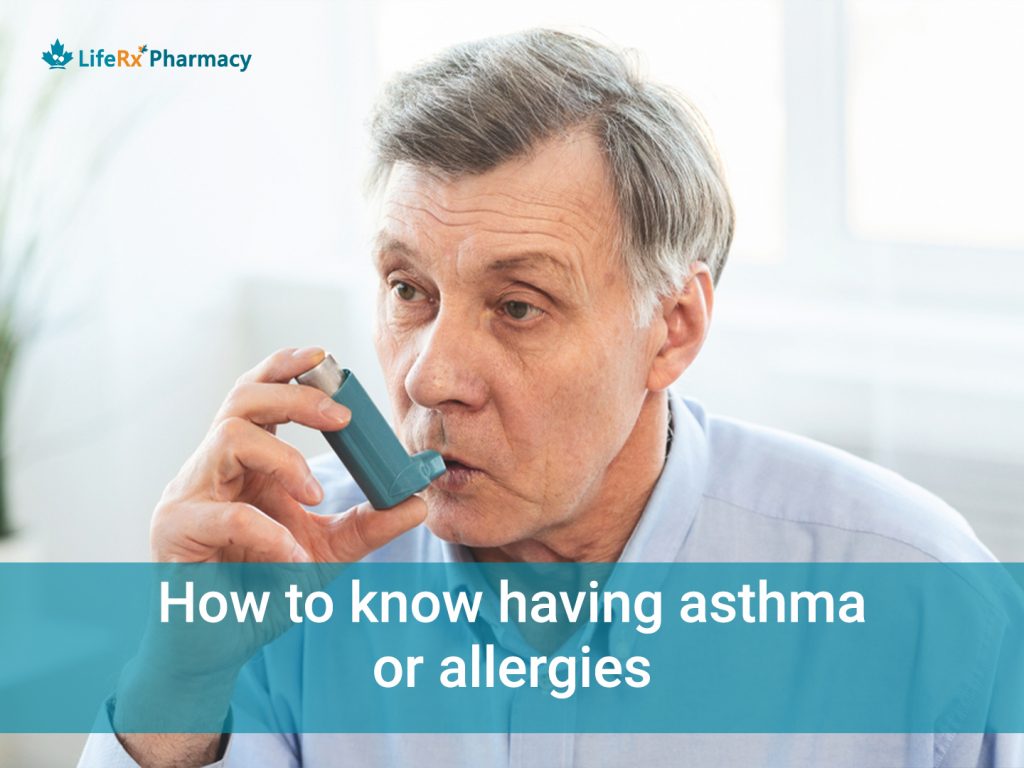Some people sneeze uncontrollably. Some people get itchy hives or runny eyes. But, regardless of the reaction, it ultimately boils down to allergies. You’re not alone if you suffer from allergies. As many as 30% of adults and 40% of youngsters in the United States are in the same boat as you. While your condition may appear to begin in the nose or eyes, allergies are the result of an overactive immune system.
Allergens can enter your body through the skin, eyes, nose, mouth, or stomach, among other places. This can clog your sinuses, inflame your skin, make breathing difficult, and create gastrointestinal issues.
Understanding why these reactions occur might assist you in maintaining control and feeling better.
The reactions of Asthma & Allergies:
When immune system proteins (antibodies) incorrectly interpret an innocuous material, such as tree pollen, as an invader, an allergic reaction develops. Antibodies bind to the allergen in an attempt to defend your body against the chemical.
It can include nasal congestion, runny nose, itchy eyes, and skin responses, which are caused by chemicals generated by your immune system. This same reaction can harm the lungs and airways in some people, causing asthma symptoms.
Both asthma and allergies can make you feel miserable. Understanding the similarities and differences between the two can help you learn to manage symptoms or potentially avoid them altogether.
Signs and Symptoms:
Our immune systems are built to defend us against potentially dangerous threats. Allergies develop when our immune systems react to something that isn’t harmful, such as food, pollen, dust, a bug bite, medication, or something else.
Common symptoms of asthma include:
- Coughing (Nocturnal Cough),
- Wheezing,
- Shortness of breath,
- Chest tightness, pain, or pressure.
Despite this, not everyone with asthma experiences the same symptoms in the same way. You may not experience all of these symptoms at the same time, or you may experience them in various ways. Your asthma symptoms may also differ from one asthma episode to the next, with one being minor and the next being severe.
Some persons with asthma may go for long periods without experiencing any symptoms, only to be interrupted by asthma attacks, which are periodic worsening of their symptoms. Others may experience asthma symptoms daily. Furthermore, some people may only experience asthma when they exercise or when they have viral infections such as colds.

Knowing what is an Asthmatic Attack:
An asthma attack is characterized by the tightening of the bands of muscle that surround the airways. Bronchospasm is the medical term for this tightening. The lining of the airways becomes swollen or inflamed during an attack, and the cells that line the airways generate more and thicker mucus than usual.
Breathing difficulties, wheezing, coughing, shortness of breath, and trouble doing routine everyday activities are all indications of bronchospasm, inflammation, and mucus production.
Other signs and symptoms of an asthma attack are:
- Severe wheezing when during Inhaling & Exhaling,
- Coughing that won’t stop,
- Very rapid breathing,
- Chest pain or pressure,
- Tightened neck and chest muscles, called retractions,
- Difficulty talking,
- Feelings of anxiety or panic,
- Pale, sweaty face,
- Blue lips or fingernails.
Because the intensity of an asthma attack can quickly worsen, it’s critical to treat these asthma symptoms as soon as you see them.2
Asthma Action Plan:
A documented Asthma Action Plan should be kept by everyone who suffers from asthma. The information and recommendations in this plan will help you manage your asthma. It includes sections on drugs, how to recognize when your symptoms are getting worse, and what to do in an emergency. Download and print this form if you don’t already have an asthma action plan. Bring it to your doctor to get it filled out for you. Asthma Action Plans also inform teachers and other caregivers of your child’s asthma. It’s appropriate to provide it to teachers, school nurses, and after-school care workers.3
Managing Asthma:
You can keep your asthma under control and avoid an attack by following your doctor’s instructions and avoiding triggers. Asthmatics do not all take the same medication. Some medicines are inhaled (breathed in), while others are administered as pills. There are two sorts of asthma medications: those that provide immediate relief and those that provide long-term control. Asthma attack symptoms are controlled with quick-relief medications.
If you find yourself needing to use your pain relievers more frequently, consult your doctor to see if you require a new medication. Long-term asthma management medications help you have fewer and milder attacks, but they won’t help you if you’re suffering an attack.
Asthma medications can cause side effects, but they are usually minor and go away quickly. Inquire about the side effects of your medications with your doctor. It’s crucial to understand that you have control over your asthma. Make your asthma management plan with the advice of your healthcare provider so you know what to do based on your symptoms. Determine who should receive a copy of your plan and where it should be kept. Even if you don’t have symptoms, take your long-term control medicine.
Asthma Treatment:
Long-term control medicines: For the treatment of asthma, corticosteroids remain the most strong and effective anti-inflammatory medicines available. They can help individuals of all ages with all types of chronic asthma. Inhaled steroids are often recommended over oral steroids for long-term use because they have fewer systemic side effects. Oral steroid medication is mainly reserved for the treatment of resistant, severe, and persistent asthma. The dosages of inhaled corticosteroids depend on the severity of the disease. Most patients can be maintained on two daily doses of the currently available preparations
Side Effects:
Cough, Dysphonia, Throat discomfort, and Oropharyngeal Candidiasis are all common adverse effects. Patients can lessen the incidence of local adverse effects, including candidiasis, by using a spacer, rinsing their mouth after each use, and using inhaled steroids less frequently (twice daily rather than four times daily). Higher doses may cause systemic side effects such as adrenal suppression, osteoporosis, and growth retardation in children.4
Short-acting medications:
Short-acting inhaled beta2 agonists are the preferred treatment for bronchospasm relief and exercise-induced bronchospasm prevention. Selective beta2 agonists, such as Albuterol, Bitolterol (Tornalate), Metaproterenol (Alupent), Pirbuterol (Maxair), and Terbutaline (Brethaire), are preferred over nonselective beta-agonists like epinephrine, ephedrine, and isoproterenol (Isuprel) because they have fewer cardiovascular side effects and Beta2 agonists inhaled have a quick beginning of effect (i.e., less than five minutes). The period of action is three to eight hours, with peak bronchodilation occurring within 30 to 60 minutes.
Short-term systemic corticosteroid therapy can help manage asthma symptoms and treat moderate to severe asthma exacerbations. 23 When gastrointestinal absorption is not hindered, intravenous injection of systemic corticosteroids has no advantage over oral administration.
Prednisone, prednisolone, or methylprednisolone in a dosage of 40 to 60 mg per day taken as one or two daily doses is recommended for adults; for children, 1 to 2 mg per kg per day to a maximum dosage of 60 mg per day is recommended.
Follow-up visits (every one to six months) are required to check that good control is maintained and to determine whether a “step-up” or “step down” in therapy is required. Symptoms (cough, dyspnea, nocturnal symptoms, impairment in any activity) and how often quick-relief medication is used should be carefully questioned.
For patients with moderate to severe chronic asthma and whenever exacerbations occur, daily home peak flow monitoring is recommended. Peak flow measurements can be beneficial during office visits. Spirometry should be done every one to two years to ensure that airway function is maintained.
When asthma is under control, it’s time to reduce the amount of medication you’re taking. The last medicine taken to the regimen is usually the first to be removed. Every two to three months, the dosage of inhaled corticosteroids can be reduced by 25% to the lowest dose required to maintain control.
FAQs:
What tests are used to diagnose allergic asthma?
Lung Function Test: They determine how well your lungs are functioning. They’re used by doctors to diagnose asthma and track its progression. Lung function tests are usually performed in an exam room with particular instruments that assess lung function. The examinations are likely to be performed by a specially trained respiratory therapist or technician. Inquire with your doctor whether there is anything you can do to prepare for your lung function tests. You might need to modify your medicine, for example. You should also avoid eating a lot of food, smoking, and any irritants or other chemicals that could cause an asthma attack. A few tests are Spirometry, Challenge test, Peak flow meter test, and nitric oxide test.
If you have an allergy, is it possible to have asthma?
As it turns out, quite a bit. Allergies and asthma are frequently found together. Pollen, dust mites, and pet dander, all of which can induce hay fever (allergic rhinitis) symptoms, can also cause asthma signs and symptoms. Skin or food allergies might trigger asthma symptoms in certain people.
What are tests that can find Asthma?
The FeNO test (FeNO stands for fractional exhaled nitric oxide) involves inhaling into a machine that detects the amount of nitric oxide in your breath, which is a symptom of pulmonary inflammation. Spirometry is a test that involves blowing into a machine to determine how quickly you can exhale and how much air you can hold in your lungs. The peak flow test involves blowing into a handheld instrument that measures how quickly you can exhale, and it may be repeated multiple times over a few weeks to see if it changes.
Can we call asthma – An allergy?
When allergies combine with a breathing condition- asthma, it’s called allergic asthma. Allergic asthma is a kind of asthma in which your airways tighten when you breathe in an allergen. Something in the air can cause this, such as pollen, dander, or mold spores. Hence, we can call asthma a part of an allergic response.
Can an allergy to dust be considered asthma?
Dust allergy is an allergic reaction to microscopic insects found in household dust. The symptoms of dust mite allergies are similar to those of asthma, such as sneezing and a runny nose. Adding to those symptoms, they can have wheezing and difficulty breathing. Moreover, Dust might be an asthma trigger, so avoiding it can be beneficial.
What are the symptoms of asthma?
Breathing difficulties, wheezing, coughing, shortness of breath, and trouble doing routine everyday activities are all indications of bronchospasm, inflammation, and mucus production.
What is the correlation between asthma and allergies?
Allergies and asthma are frequently found together. Pollen, dust mites, and pet dander, all of which can induce hay fever (allergic rhinitis) symptoms, can also cause asthma signs and symptoms. Skin or food allergies might trigger asthma symptoms in certain people. Allergy asthma is also known as allergy-induced asthma. Allergic rhinitis and positive allergen skin test results are key risk factors for asthma development. Patients with allergic rhinitis are three times more likely to develop asthma. Surprisingly, the improvement of asthmatic symptoms correlates with the relief of allergic symptoms over time. Patients with more severe and long-lasting allergic rhinitis are more likely to develop asthma.
References:
- https://www.mayoclinic.org/diseases-conditions/asthma/in-depth/allergies-and-asthma/art-20047458
- https://www.webmd.com/asthma/asthma-symptoms
- https://www.aafa.org/asthma-treatment-action-plan/
- https://www.aafp.org/afp/1998/0701/p89.html


